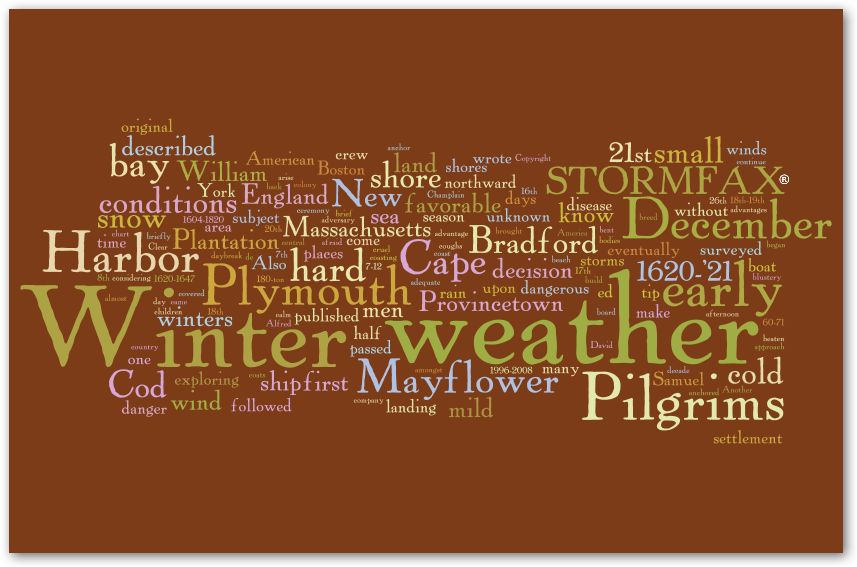



The decision of the Pilgrims to land on the shores of Massachusetts was dictated by the weather. At the time the Mayflower was passing the southeastern tip of Cape Cod, the wind and waves prompted the crew to make landfall out of danger rather than proceed to their planned destination at New York Harbor.
The small 180-ton ship passed the central headland of Cape Cod near Nauset soon after daybreak on November 19, 1620, but found itself in the dangerous shoals east of Monomoy Point. The Pilgrims turned back northward, taking advantage of the south wind and eventually found safety rounding the northern tip of the Cape into the protected waters of the bay. Clear weather and a favorable wind held on the 20th and 21st, speeding the ship northward. The Mayflower dropped anchor early in the morning of the 21st in Provincetown Harbor after 65 days at sea. (1)
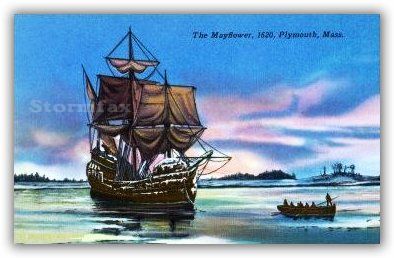 William Bradford, historian and later governor of Plymouth Plantation, described what faced the Pilgrims at Provincetown:
William Bradford, historian and later governor of Plymouth Plantation, described what faced the Pilgrims at Provincetown:
More favorable weather followed the storm. After two days of drying out, exploring the small island, and sounding the harbor, the famous landing took place on December 21st, from a small rowboat and not from the larger ship, on a sandy beach and not on a "rock," by only ten men and not with women and children, and without ceremony as the men were afraid of meeting hostile natives on shore. After a reconnaissance showed the area to have some advantages over other places recently surveyed, the small boat returned to Provincetown and the entire company came over on the Mayflower on December 26th. The decision was made to found the colony on the surveyed site at Plymouth, in part by the weather: (1)
Despite the generally warmer than normal conditions, almost half of the original passengers and crew of the Mayflower succumbed to disease during the first winter on the shores of Massachusetts and Cape Cod Bay. Many lived on board the Mayflower anchored a mile-and-a-half offshore and went to the land each day, weather permitting, to build adequate shelters. William Bradford described the winter weather as blustery with much rain. (2)
Most early Pilgrim writers dwelt very briefly on the subject of New England weather, bent on sending favorable reports to please their sponsors in England or on trying to persuade other settlers to make the hard decision to come to America.
There is no detailed information as to the nature of subsequent winters during the first decade of settlement at Plymouth, but we know life was hard on that rough shore where the approach of winter led the Pilgrims to establish their settlement. It was a marginal existence with the weather more an adversary than a friend. Each winter was a dreaded season.
(2) William Bradford. Of Plymouth Plantation 1620-1647.
Samuel E. Morison, ed. New York, Alfred A. Knopf, 1952. 60-71.
(3) Mourt's Relation or Journal of the Plantation at Plymouth.
Henry M. Dexter, ed. Boston, John Kimball Wiggin, 1865. 39.
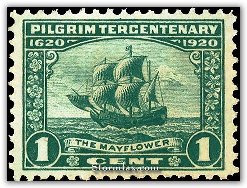
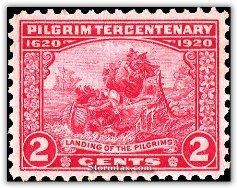
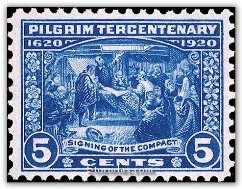
 Please read our Legal Notice and our Privacy Statement.
Please read our Legal Notice and our Privacy Statement.